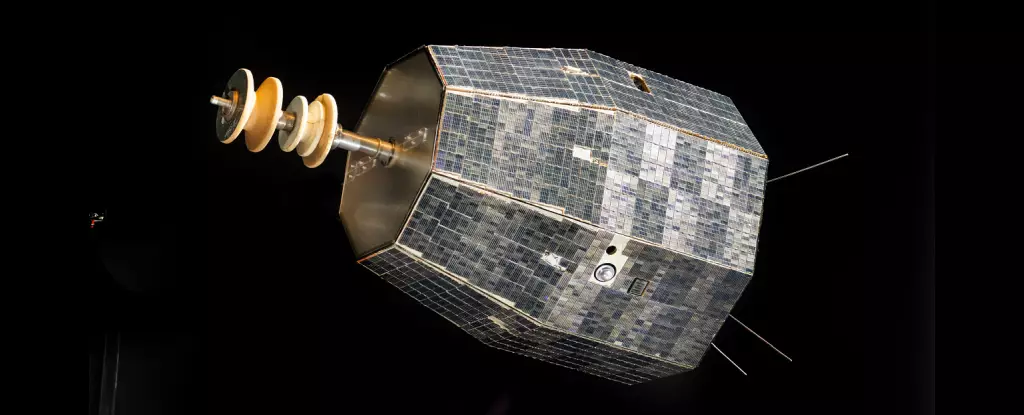In a significant twist in the realm of astronomical phenomena, a fast radio burst (FRB), known for its enigmatic and unexplained origins in deep space, has been traced back to an old, forgotten source: a NASA satellite named Relay 2. This observance, which transpired on June 13, 2024, provides an extraordinary insight into the intersection between human technology and cosmic mysteries. The situation has ignited intense discussions regarding the implications of anthropogenic signals amid our expanding presence in space.
Astrophysicists have feverishly worked to understand the nature of FRBs, brief yet powerful emissions from distant celestial entities that could embody the seismic energy of hundreds of millions of stars packed within a fraction of a second. Until recently, these colossal signals were interpreted to originate from phenomena light-years away, adding to the intrigue surrounding potential extraterrestrial communications. However—with this revelation—scientists have illuminated an unexpected narrative; one that showcases the unintentional consequences of human intervention in space.
The Forgotten Sentinel in Space
The origin of this particular FRB, previously thought to be an indicator of foreign signals, has unveiled a humbler story, grounded in Earth’s orbit. Launched in 1964 and rendered obsolete by 1967, the Relay 2 satellite had been silently drifting in space for more than half a century. Its re-emergence in the spotlight as a culprit for the FRB offers an unsettling reminder of our responsibilities in managing space debris and contaminants. The fact that a tool designed for human communication inadvertently contributed to scientific discovery underlines the necessity for vigilance regarding our extraterrestrial footprint.
Researchers from Curtin University, led by astronomer Clancy James, employed the Australian Square Kilometer Array Pathfinder (ASKAP) to detect and analyze this burst over a bandwidth of 695.5 MHz to 1031.5 MHz. Through intricate analysis of the time delays in the signal, this unusual breakthrough traced the burst back to the inactive satellite, demonstrating how ancient technology can still impact modern astronomical research.
Understanding the Signal’s Nature
Far from being a beacon of alien civilization, the report indicates potential explanations rooted in earthly phenomena—specifically, either an electrostatic discharge or a plasma discharge triggered by a minor micrometeoroid impact. Remarkably, scientists suggest that this could be due to electrons that accumulate around the satellite while navigating through Earth’s magnetic environment. When the voltage reached critical levels, the discharge occurred, leading to the signal detected across vast distances.
This incident not only addresses the immediate curiosity surrounding the burst but also compels researchers to reconsider how signals from deteriorating space technology could be misconstrued as celestial phenomena. The potential connection to past signals, particularly those received from GPS satellites, creates a necessary framework for understanding and categorizing future signals that may emerge from other antiquated devices lingering in space.
Transforming the Search for Cosmic Mysteries
The Relay 2 case transforms our approach to studying radio signals and cuts through the noise of assumptions surrounding deep space communications. As astronomers adapt to a technologically-sophisticated complex, it’s crucial to delineate signals from mechanical sources versus those potentially stemming from extraterrestrial intelligences. The lessons gleaned from this incident serve a dual purpose: they emphasize the need for caution when interpreting signals and highlight the importance of thorough data examination of satellite emissions.
Moreover, the findings may prompt the development of new observational techniques specifically tailored to detect and interpret discharges from aging technology orbiting Earth. As we continue to explore the universe, it becomes increasingly vital to consider not just what signals we find, but how we categorize and understand them relative to our own technological artifacts.
Navigating a New Era in Astronomy
The investigation into this FRB represents a watershed moment for astronomy, underscoring how human-designed spacecraft can create disruptions that mimic cosmic signals. Within the mesmerizing dance between human technology and outer space, we are reminded that there are still many unforeseen challenges as we continue to stretch our reach beyond our planet.
The research community is now faced with both an opportunity and an obligation: as we advance in our understanding of the cosmos, we must remain acutely conscious of our role and impact on it. Failure to address the potential for confusion between earthly and cosmic signals could lead us down an erroneous path in our quest for signs of intelligent life beyond our world.
As we endeavor to unveil the many mysteries of fast radio bursts, we stand at a crossroads where the past informs the future, ultimately guiding us toward a deeper understanding of our universe and our place within it. The remarkable journey of Relay 2, from silence to discovery, encapsulates the continuing saga of humanity’s exploration of the cosmos, confirming that sometimes the most astonishing revelations come from the most unexpected of places.

